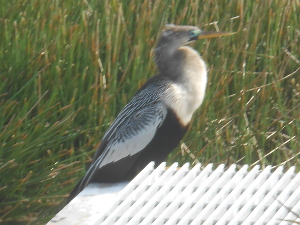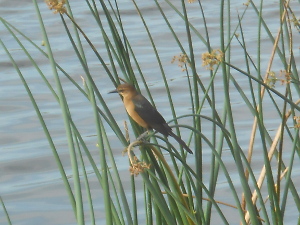 Anhinga close to us
Anhinga close to us Anhinga close to us
Anhinga close to us
When we visited the local wetlands reserve in Melbourne, Florida, we almost didn't look for alligators. Instead, we looked for, and found, birds.
This wetlands was made by the water department of Melbourne. The city is growing, and developers have moved out into the areas surrounding the city, scooping out land to fill the places where they are building houses. Now a collection of ponds, separated by high wide dikes, covers the area, allowing cars, bikes and walkers to take their time admiring the birds. They would admire the alligators, too, but we didn't see any on this visit.
We discovered a new bird, one we hadn't known about: the anhinga. The  Female grackle
internet describes it thus: A bird of southern swamps, the Anhinga is known as the Water-Turkey for its swimming habits and broad tail, and also as the Snake-Bird for its habit of swimming with just its long head and neck sticking out of the water.
Female grackle
internet describes it thus: A bird of southern swamps, the Anhinga is known as the Water-Turkey for its swimming habits and broad tail, and also as the Snake-Bird for its habit of swimming with just its long head and neck sticking out of the water.
We did see it swimming, where it looked as though it would like to be the Loch Ness monster, just the neck and head, gliding along through the water like a submarine with its conning tower raised. But most of the time we saw them on pilings or tree stumps, where they could scan the water for fish. Here are some photos.
There were lots of additional birds, all of them beautiful. We loved  Anhinga on a palm stump
the female grackle and all the different herons.
Anhinga on a palm stump
the female grackle and all the different herons.
One of the very pleasant parts of the walk was seeing the other visitors, all of us calm and happy and, generally, smiling, as we slowly passed each other. Quite a few visitors had cameras with enormous lenses: one, sticking out of a car window, looked like the head of a giant dog until we got close enough to see what it readly was. Here and there a collection of people would indicate a sighting of something special, collecting additional spectators. Sometimes a person in a car would call out what they just spotted, pointing to the spot where the bird had just been seen.